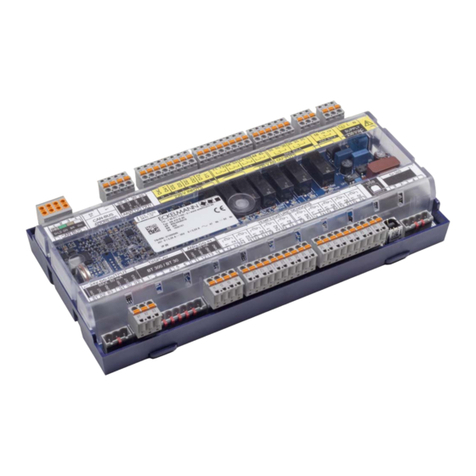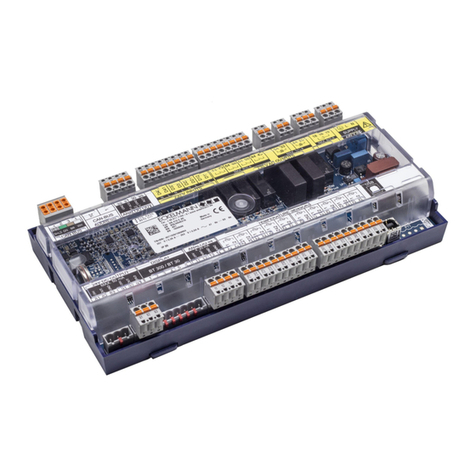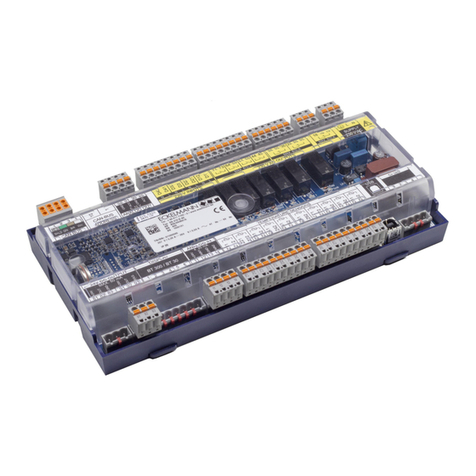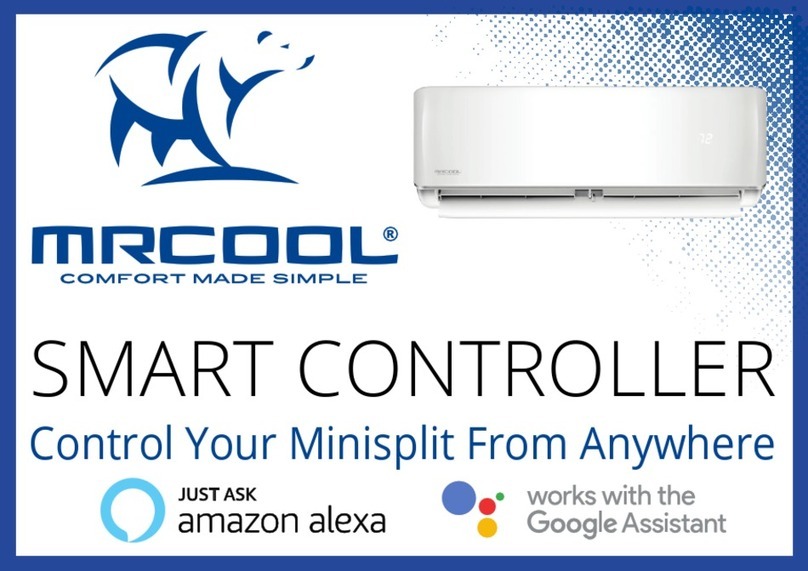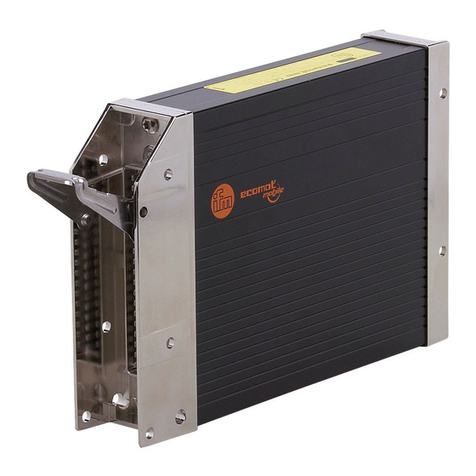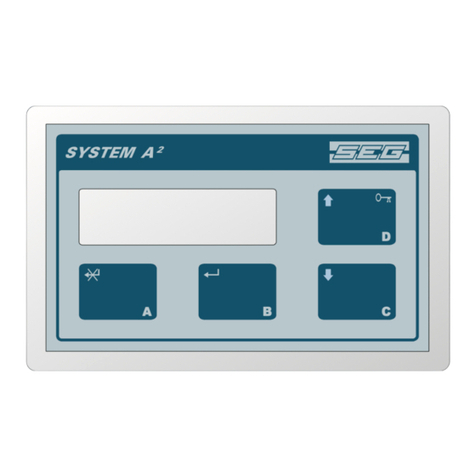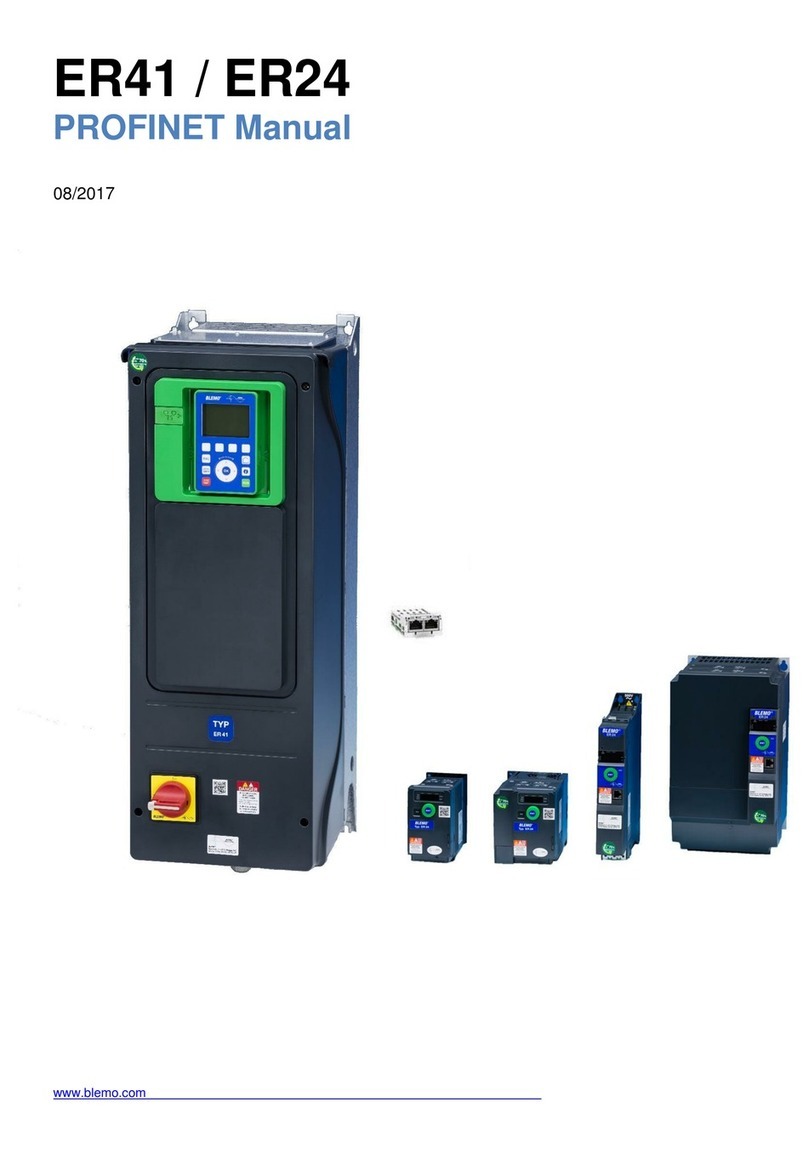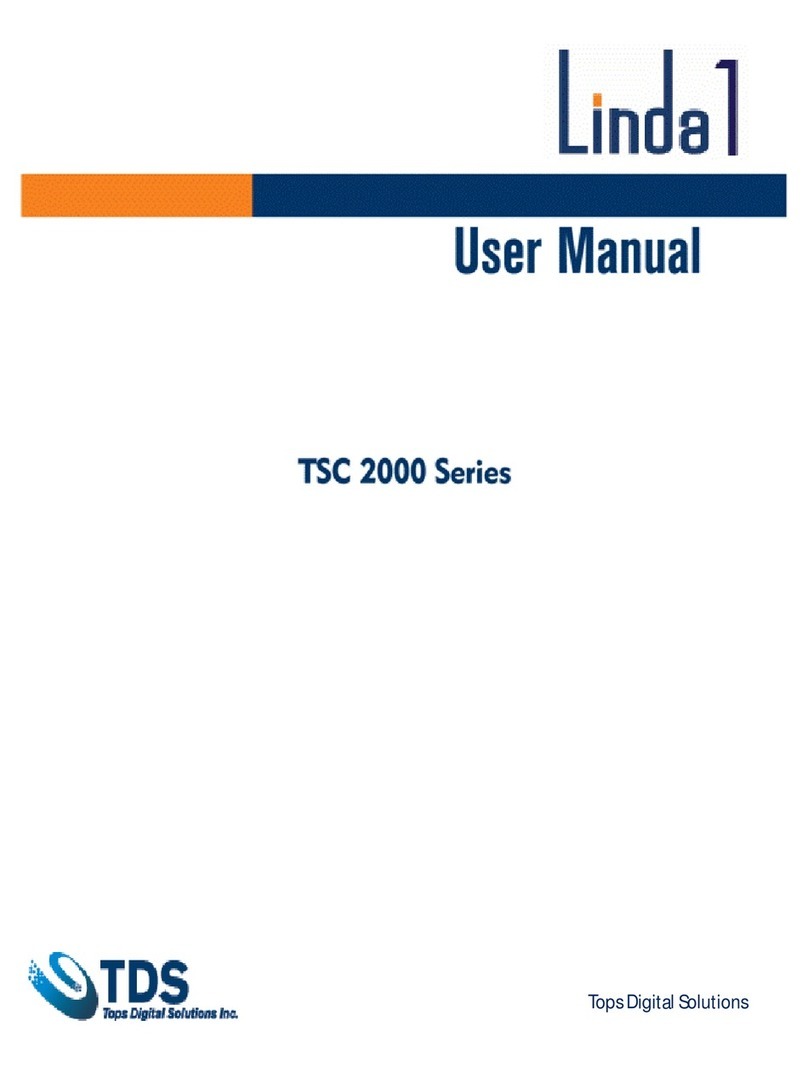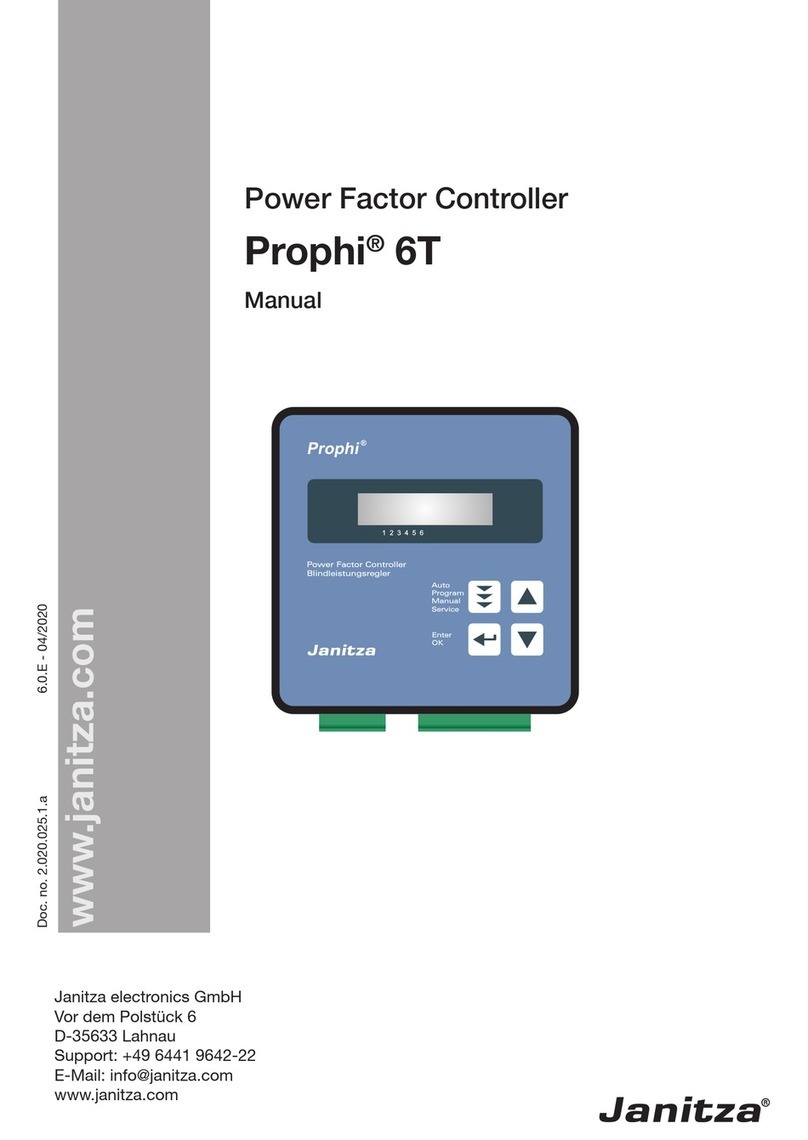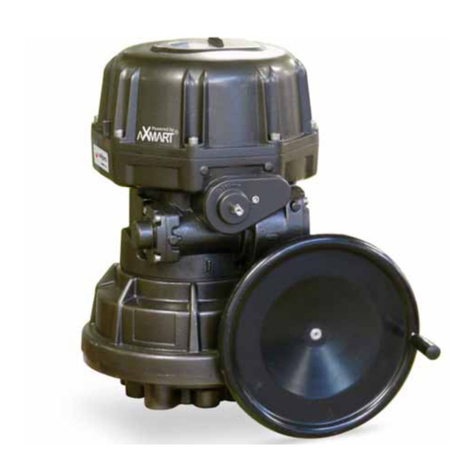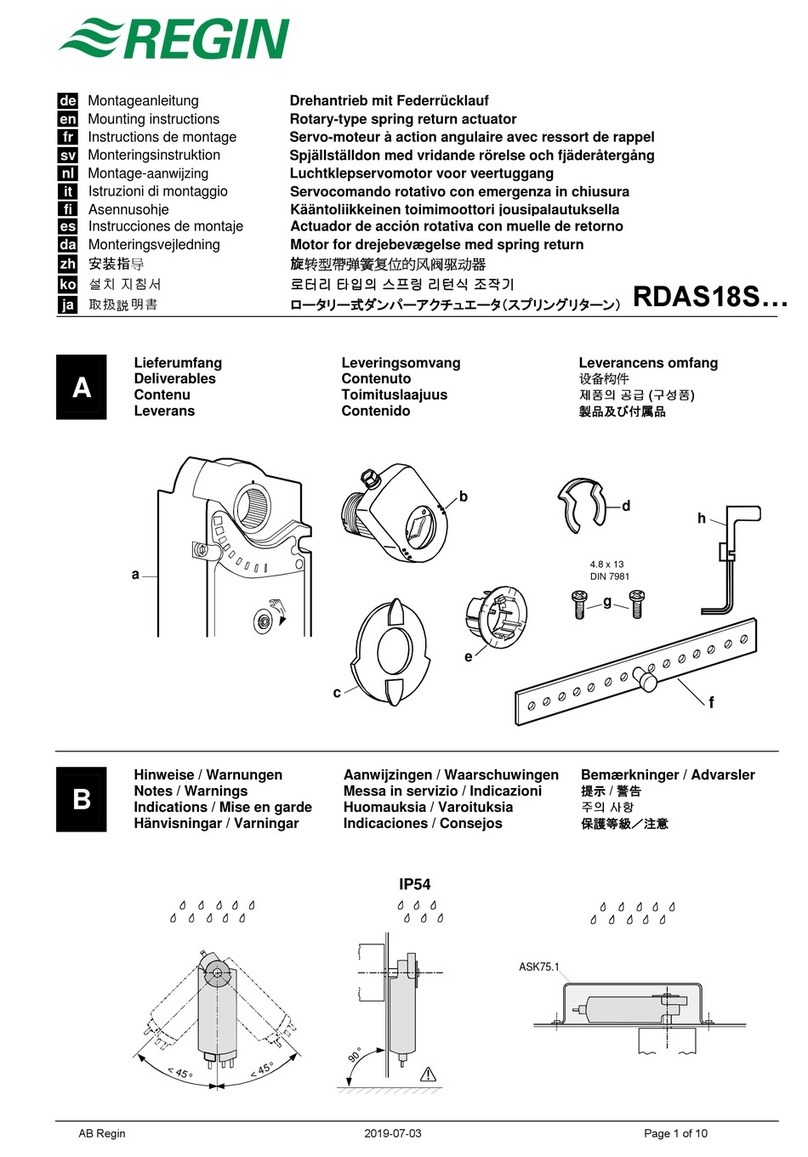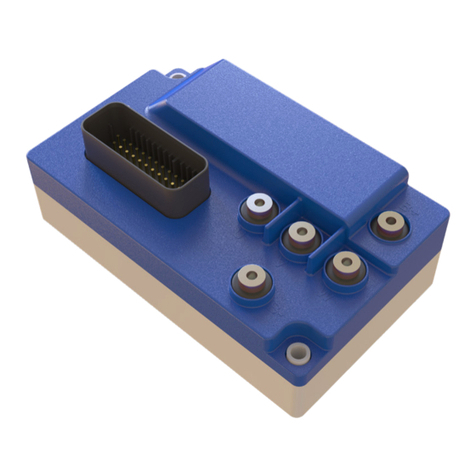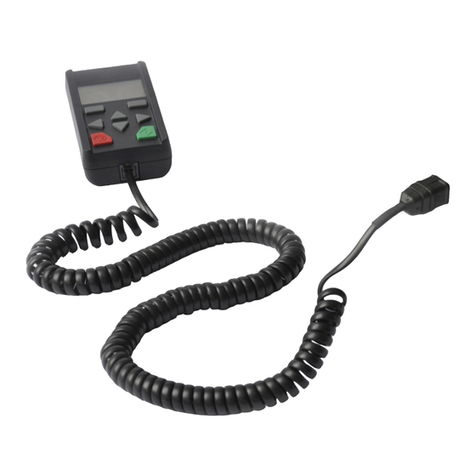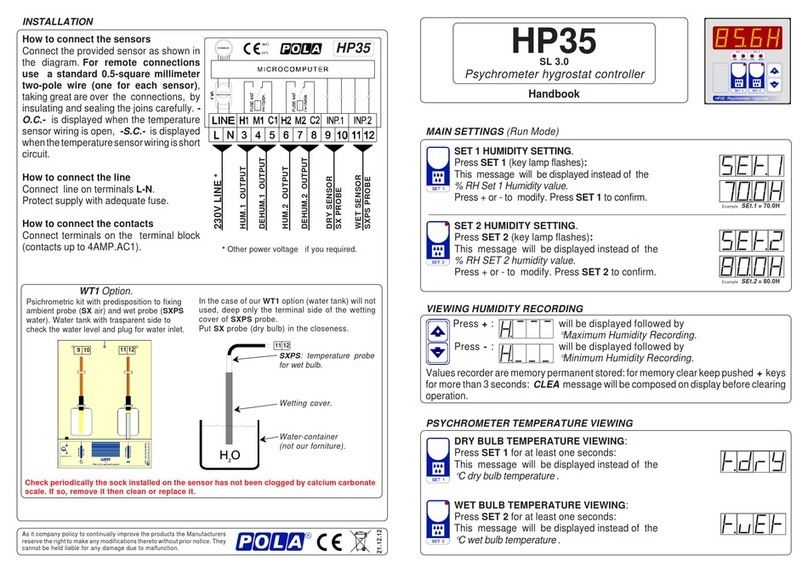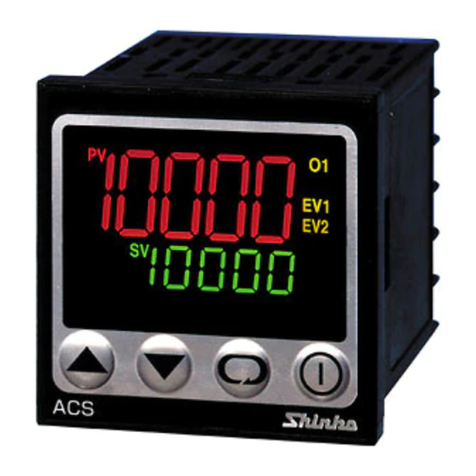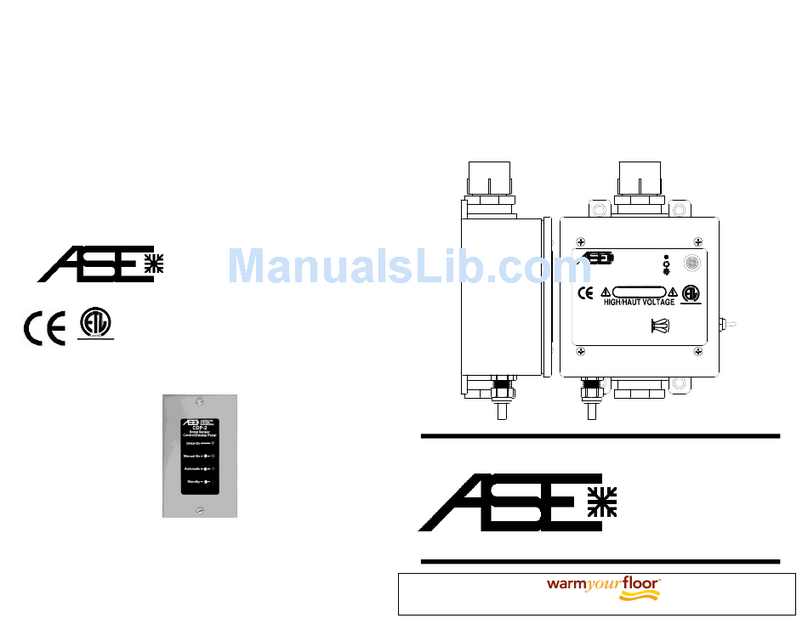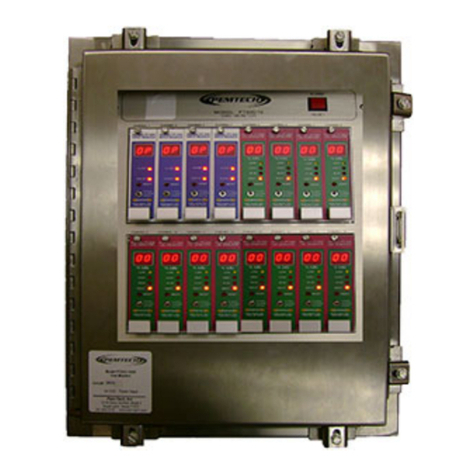ECKELMANN VS 3015 CT User manual

Firmware V1.41 V1
08.11.2022
Doku 1.8
Operating instruction
VS 3015 CT
Pack Controller for transcritical CO2 systems

Firmware V1.41 V1
08.11.2022
2/219
Eckelmann AG
Business Unit Refrigeration and Building Automation
Berliner Straße 161
65205 Wiesbaden
Germany
Telephone +49 611 7103-700
Fax +49 611 7103-133
www.eckelmann.de
Board of Management:
Chairman Dipl.-Wi.-Ing. Philipp Eckelmann,
Dipl.Ing. (FH), Dipl.-Ing. (FH) Volker Kugel,
Dr.-Ing. Marco Münchhof
Supervisory Board: Hubertus G. Krossa
Deputy Chairman of the Supervisory Board: Dr.-Ing. Gerd Eckelmann
Seat of the company Wiesbaden, district court Wiesbaden HRB 12636
VAT ID: DE 113841021, WEEE Reg. No.: DE 12052799
Before commissioning and use, please check that this is the latest version of the document. With the
publication of a new version of the documentation, all previous versions lose their validity. The current operating
manual and information such as data sheets, more detailed documentation and FAQs are available for you on-
line in E°EDP (Eckelmann ° Electronic Documentation Platform) at
www.eckelmann.de/elds
You reach all relevant documents for this component directly using the QR code:
https://edp.eckelmann.de/edp/lds/_06ec586hZi
Information on safety and connection instructions are described in detail in chapter ”Industrialsafety notes”.
Copyright: All rights to any use whatever, utilisation, further development, forwarding and creation of copies
remain with the Eckelmann AG company. In particular, neither the contract partners of Eckelmann AG nor other
users have the right to distribute or market the IT programs/program parts or modified or edited versions
without express written permission. To some extent, names of products/goods or designations are protected for
the respective manufacturer (registered trademarks etc.); in any case, no guarantee is assumed for their free
availability/permission to use them. The information provided in the description is given independently of any
existing patent protection or other third-party rights.
Errors and technical modifications are expressly reserved.

Firmware V1.41 V1
08.11.2022
3/219
Table of Contents
1 Conventions............................................................................................................................................9
1.1 Warning signs, symbols and text formatting used in this manual....................................................9
1.2 Explanation of text formatting ............................................................................................................10
2 Safety instructions ...............................................................................................................................11
2.1 Disclaimer in the event of non-compliance .......................................................................................12
2.2 Requirements for the personnel .........................................................................................................12
2.3 Intended Use.........................................................................................................................................13
2.4 Five safety rules according to DGUV Regulation 3...........................................................................13
2.5 Electrostatic-sensitive components and control components (ESD).............................................14
2.5.1 ESD - Rules for handling and working ...................................................................................................14
2.6 Abbreviations Used..............................................................................................................................14
3 System design VS 3015 CT .................................................................................................................15
4 VS 3015 CT Functions..........................................................................................................................17
5 VS 3015 CT Function............................................................................................................................20
5.1 Starting Characteristics.......................................................................................................................20
5.1.1 First start ................................................................................................................................................20
5.1.2 Restart....................................................................................................................................................20
5.2 System Configuration ..........................................................................................................................20
5.2.1 LT control circuit for booster systems - as combined control .................................................................20
5.3 Configuration of the pressure transmitters .......................................................................................21
5.3.1 Low Pressure Transmitter Z2 (LP-Z2) ....................................................................................................22
5.4 Low-Pressure Regulation ....................................................................................................................22
5.4.1 Control Algorithm for LP Control.............................................................................................................23
5.4.2 Control Algorithm with LP Step Controller ..............................................................................................24
5.4.2.1 Neutral Zone with Compressor Step Control..........................................................................................25
5.4.2.2 Compressor Switching Times for Compressor Step Regulation ............................................................25
5.4.3 Control Algorithm with LP Combined Control .........................................................................................26
5.4.3.1 Switching On / Switching Off of Fixed-Speed Compressors ..................................................................27
5.4.3.2 Loading / Unloading of Fixed-Speed Compressors During Operation with Capacity-Controlled
Compressors ..........................................................................................................................................28
5.4.3.3 Neutral Zone with Compressor Combined Control ................................................................................30
5.4.3.4 Compressor Control Times for Compressor Combined Control.............................................................31
5.4.3.5 Regulation of a Pack with Different Size Compressors..........................................................................32
5.4.4 Setpoint Shift ..........................................................................................................................................35
5.4.4.1 Setpoint Shift via Room Temperature.....................................................................................................35
5.4.4.2 Setpoint Shift - Demand-Dependent via Consumer ...............................................................................36
5.4.4.3 Setpoint Shift via CAN Bus.....................................................................................................................37

Firmware V1.41 V1
08.11.2022
4/219
5.4.4.4 Setpoint Shift via External Analogue Signal ...........................................................................................37
5.4.4.5 Setpoint Shift via Humidity Sensor .........................................................................................................38
5.4.5 Base Load Rotation................................................................................................................................38
5.4.5.1 Base Load Rotation for Speed Controlled Compressors .......................................................................38
5.4.6 Load shedding........................................................................................................................................39
5.4.7 Emergency Power Mode ........................................................................................................................40
5.5 High-Pressure Regulation ...................................................................................................................41
5.5.1 Control algorithm for HP control .............................................................................................................42
5.5.1.1 Neutral Zone HP-Control........................................................................................................................43
5.5.1.2 High Pressure Setpoint Determination...................................................................................................44
5.5.2 HP control with ejectors..........................................................................................................................45
5.5.2.1 Loading and unloading behaviour of the ejectors ..................................................................................51
5.6 Gas Cooler Outlet Temperature Regulation.......................................................................................55
5.6.1 Gas cooler control via relay outputs.......................................................................................................55
5.6.2 Gas cooler package with ebm-papst fans ..............................................................................................55
5.6.3 Temperature Sensors for the Regulation................................................................................................61
5.6.4 Neutral Zone Fan Control.......................................................................................................................62
5.6.5 Control Algorithm tG with Step Controller...............................................................................................62
5.6.5.1 Switching Times for Fan Motors with Step Controller.............................................................................62
5.6.5.2 Fan Motors - Star-Delta Switching .........................................................................................................64
5.6.5.3 Parametrisation of the Switching Modes................................................................................................64
5.6.6 Control Algorithm tG with Speed Control................................................................................................66
5.6.7 Control Algorithm tG with Parallel Combined Control ............................................................................68
5.6.8 Control Algorithm tG with Stage Combined Control ...............................................................................70
5.6.9 Setpoint Calculation tG...........................................................................................................................72
5.6.9.1 Setpoint Increase tG...............................................................................................................................72
5.6.10 Input Signal for Frequency Converter ....................................................................................................72
5.6.11 Protection of the Fan Motors / Fan Motors Base Load Rotation ............................................................73
5.6.12 Kickstart..................................................................................................................................................74
5.7 Medium Pressure Regulation..............................................................................................................74
5.7.1 Control Algorithm for MP Control............................................................................................................75
5.7.2 Maintaining the MP by Limiting the HP-Valve ........................................................................................75
5.7.3 Medium Pressure Compressor...............................................................................................................77
5.7.3.1 Requirements .........................................................................................................................................77
5.7.3.2 Control of the MP Compressors .............................................................................................................78
5.7.3.3 Monitoring of the MP Compressors........................................................................................................78
5.7.3.4 Configuration of the MP Compressors ...................................................................................................78
5.8 Control of the minimum superheat using a hot gas bypass valve..................................................82

Firmware V1.41 V1
08.11.2022
5/219
5.9 Heat Recovery Mode ............................................................................................................................82
5.9.1 Activation of the HRC Mode ...................................................................................................................82
5.9.2 HRC Mode Swing Protection..................................................................................................................83
5.9.3 Setpoint Calculation in HRC Mode.........................................................................................................83
5.9.4 Changes to the Control Behaviour during HRC Mode ...........................................................................85
5.9.5 HRC mode parametrisation....................................................................................................................85
5.10 LT compressor in booster mode.........................................................................................................88
5.10.1 Control algorithm with combined control ................................................................................................90
5.10.2 LT compressor switching and standstill times ........................................................................................91
5.10.3 LT compressor monitoring ......................................................................................................................91
5.11 Oil Return ..............................................................................................................................................93
5.12 Monitoring.............................................................................................................................................93
5.12.1 Safety Chain...........................................................................................................................................93
5.12.1.1 Monitoring of Differential Oil Pressure Switch / Compressor High Pressure Limiter..............................94
5.12.1.2 Monitoring of the Compressor Motor Overload Cut-Out ........................................................................94
5.12.2 Cylinder Head Temperature Monitoring..................................................................................................96
5.12.3 Low Pressure Monitoring........................................................................................................................98
5.12.4 High Pressure Monitoring.......................................................................................................................98
5.12.4.1 High Pressure Monitoring Too High........................................................................................................98
5.12.4.2 High Pressure Monitoring Too Low ........................................................................................................99
5.12.4.3 Monitoring of the HP Valve.....................................................................................................................99
5.12.4.4 Monitoring of the HP Control Error .........................................................................................................99
5.12.5 Monitoring of the Medium Pressure .....................................................................................................100
5.12.5.1 Medium Pressure Monitoring Too High ................................................................................................100
5.12.5.2 Medium Pressure Monitoring Too Low .................................................................................................100
5.12.5.3 Monitoring of the MP Control Error.......................................................................................................100
5.12.6 Monitoring of the speed controller........................................................................................................101
5.12.7 Condenser / Fan Motors Monitoring.....................................................................................................101
5.12.8 Monitoring of Minimum Superheat .......................................................................................................101
5.12.9 Monitoring of the Gas Cooler Outlet Temperature................................................................................105
5.12.10 Monitoring of the Switching Frequency ................................................................................................106
5.12.11 Refrigerant Monitoring..........................................................................................................................107
5.12.12 Monitoring of the Fast Unload / External Off ........................................................................................107
5.12.13 Monitoring of Rupture Disk / Maximum Refrigerant Fill Level ..............................................................107
5.12.14 Accumulator fill level monitoring...........................................................................................................108
5.12.15 Oil level monitoring...............................................................................................................................108
5.13 Setpoint Switching .............................................................................................................................108
5.14 Ambient Data for Setpoint Switching ...............................................................................................108

Firmware V1.41 V1
08.11.2022
6/219
5.15 Disabling refrigeration points ...........................................................................................................108
5.16 Spray System Control........................................................................................................................109
5.17 COP......................................................................................................................................................110
5.17.1 COP monitoring....................................................................................................................................110
5.17.2 COP Optimisation................................................................................................................................. 111
5.18 Operating Data and Archiving........................................................................................................... 111
5.18.1 Operating Hours of Compressors and Fans......................................................................................... 111
5.18.2 Daily Run Times, Switching Pulses and Switch-On Rates...................................................................112
6 VS 3015 CT Installation and Start-Up ...............................................................................................113
6.1 DIN Rail Mounting ..............................................................................................................................113
6.2 Default hardware settings .................................................................................................................113
6.2.1 SIOX Extension Module - for DIN rail mounting...................................................................................115
6.2.1.1 Connecting the SIOX-Modules to the Pack Controller .........................................................................115
6.2.1.2 SIOX - Status LEDs..............................................................................................................................117
6.2.2 Default settings using S1......................................................................................................................117
6.2.3 Setting the CAN Bus Address via Decade Switch S2 ..........................................................................119
6.2.4 Settings for RS485/TTY Interface via Jumper J1.................................................................................121
6.2.5 Setting of the interface of the internal SIOX using jumper J2 ..............................................................121
6.2.6 Factory Setting of Analogue In- and Outputs .......................................................................................121
6.2.7 Power Supply .......................................................................................................................................122
6.2.7.1 Status LEDs .........................................................................................................................................122
6.3 Default parameter settings ................................................................................................................123
6.4 Start-Up of Speed-Controlled Condeser Fans / Compressors ......................................................124
6.4.1 Procedure for the start-up of a system.................................................................................................126
6.5 Commissioning fan control via Modbus ..........................................................................................131
6.6 Battery Replacement..........................................................................................................................133
6.7 Firmware Update ................................................................................................................................134
6.7.1 Requirements for Firmware Update .....................................................................................................134
6.7.2 Updating the current Firmware.............................................................................................................135
7 VS 3015 CT Connection and Terminal Assignment ........................................................................138
7.1 Connector Pin Assignment ...............................................................................................................139
7.1.1 VS 3015 CT Basic Module Connector Pin Assingments ......................................................................139
7.1.2 SIOX Extension Module Connector Pin Assignments..........................................................................140
7.2 Terminal Diagrams for Basic Module and SIOX ..............................................................................141
7.2.1 Terminal assignment of the 230 V AC power supply............................................................................141
7.2.2 Terminal assignment of the 230 V AC digital inputs .............................................................................142
7.2.3 Terminal assignment of the relay outputs 230 V AC ............................................................................145
7.2.4 Terminal assignment of the analogue inputs........................................................................................147

Firmware V1.41 V1
08.11.2022
7/219
7.2.5 Connector Pin Assignment for Analogue Outputs ................................................................................148
7.2.6 Connector Pin Assignment for CAN-Bus, SIOX and Interfaces ...........................................................149
7.2.6.1 Terminal assignment of the Modbus analogue module 0..10 V DC .....................................................151
7.2.6.2 Terminal assignment of the Modbus relay module 230 V AC...............................................................153
8 VS 3015 CT Operating Modes ...........................................................................................................157
8.1 Emergency Mode via Manual / Automatic Selection.......................................................................157
8.2 Service Mode ......................................................................................................................................158
8.3 Display of the Operating States ........................................................................................................158
9 VS 3015 CT Operation........................................................................................................................160
9.1 Operation Possibilities ......................................................................................................................160
9.2 Remote Control via Terminal.............................................................................................................160
9.2.1 Menus and Operating Screens.............................................................................................................162
9.2.2 Call Controller Menu using Remote Operation.....................................................................................164
9.2.2.1 CI 4x00 System Centre - Remote Control............................................................................................165
9.2.2.2 CI 3x00 Store Computer / AL 300 Operator Terminal - Remote Control ..............................................165
9.2.3 Deactivating the Input Lock ..................................................................................................................166
9.2.3.1 CI 4x00 System Centre - Log-In and Log-Out......................................................................................166
9.2.3.2 CI 3x00 Store Computer/ AL 300 Operator Terminal - Unlock .............................................................167
9.2.4 Activating Service Mode.......................................................................................................................167
9.2.4.1 CI 4x00 System Centre Service Mode .................................................................................................167
9.2.4.2 CI 3x00 Store Computer - Service-Mode .............................................................................................167
10 VS 3015 CT Menu Structure ..............................................................................................................169
10.1 Menu tree ............................................................................................................................................169
10.1.1 Menu 0 Main menu...............................................................................................................................171
10.1.2 Menu 1 Summary .................................................................................................................................171
10.1.3 Menu 2 Actual values ...........................................................................................................................172
10.1.4 Menu 3 Setpoints .................................................................................................................................176
10.1.5 Menu 4 Clock .......................................................................................................................................204
10.1.6 Menu 5 Messages ................................................................................................................................204
10.1.7 Menu 6 Operating Data ........................................................................................................................206
10.1.8 Menu 7 Default Settings .......................................................................................................................208
10.1.9 Menu 8 Service Mode ..........................................................................................................................208
11 Decommissioning and Disposal .......................................................................................................211
11.1 Decommissioning / Dismantling.......................................................................................................211
11.2 Disposal ..............................................................................................................................................211
12 Alarms and Messages VS 3015 CT ...................................................................................................212
12.1 Message System ................................................................................................................................212
12.2 Message Structure .............................................................................................................................212

Firmware V1.41 V1
08.11.2022
8/219
12.2.1 Automatic Priorisation ..........................................................................................................................213
12.3 Overview of all alarms and messages..............................................................................................213
13 Technical Data VS 3015 CT / SIOX ....................................................................................................216
13.1 Electrical Data VS 3015 CT / SIOX ....................................................................................................216
13.2 Mechanical Data VS 3015 CT.............................................................................................................217
13.3 Mechanical Data SIOX Extension Module........................................................................................218
14 Part Numbers and Accessories VS 3015 CT....................................................................................219
14.1 Pack Controller VS 3015 CT / SIOX Extension Module...................................................................219
14.2 Accessories for VS 3015 CT..............................................................................................................219

Firmware V1.41 V1
08.11.2022
9/219
•
•
•
•
•
1 Conventions
1.1 Warning signs, symbols and text formatting used in this manual
Explanation of the warning signs, symbols and text formatting used in this operating and service manual:
DANGER
WARNING
CAUTION
*IfanyofthesesymbolsDANGER/WARNING/CAUTION is recognized, the user must refer to the operating
manual in order to understand the type of potential HAZARD and the required actions for avoiding the
HAZARD. Carefully observe all health and safety instructions and use particular caution in these situations.
Failure to observe the DANGER/WARNING/CAUTION symbols will cause injury (in the worst case,
severe injury or death) and/or damage to property!
ATTENTION
NOTICE
DANGER
Instructions with this symbol and/or the signal word DANGER warn the user of situations that will
cause severe injury or death if the specified instructions are not observed! *
WARNING
Instructions with this symbol and/or the signal word WARNING warn the user of situations that may
cause severe injury or death if the specified instructions are not observed! *
CAUTION
Instructions with this symbol and/or the signal word CAUTION warn the user of situations that may
cause moderate or minor injury if the specified instructions are not observed! *
ATTENTION
Instructions with this symbol and/or the signal word ATTENTION warn the user of situations that may
cause damage to property if the specified instructions are not observed! The ATTENTION symbol
highlights guidelines and regulations, instructions and proper working procedures that must be
particularly observed in order to prevent damage to and destruction of components or malfunctioning.
Failure to observe the ATTENTION symbol will cause damage to property!
NOTICE
Instructions with this symbol and/or the signal word NOTICE provide tips and useful additional
information.

Firmware V1.41 V1
08.11.2022
10/219
•
•
•
1.
2.
3.
4.
1.
2.
ELECTRIC SHOCK
Risk of fatal electric shock!
This symbol warns of danger from dangerous voltage with possible consequences such as severe injury and death. If this symbol
is seen, the user must refer to the operating manual in order to understand the type of potential HAZARD and the required actions
for avoiding the HAZARD. Carefully observe all health and safety instructions and use particular caution in these situations.
Failure to observe the WARNING symbol will cause injury (in the worst case, severe injury or death) and/or damage to
property!
ESD - Electrostatic-sensitive components and control components
DISPOSAL
Potential negative impact on people and the environment due to non-environmentally friendly disposal.
The strike-through dustbin symbol indicates the duty to dispose of items properly. Do not dispose of this product with other
domestic waste, see chapter Disposal. Please inform yourself about the local regulations for the separate disposal of electrical and
electronic products. The correct disposal of your old equipment protects people and the environment from possible negative
impact.
1.2 Explanation of text formatting
Safety instructions or hazard warnings are composed of four elements:
Thesymbol with text (e.g. for DANGER),
a concise description of the hazard and
a description of the possible consequences.
Where applicable, a catalogue with measures for avoiding the hazard.
For example:
A general instruction consists of two elements:
Thesymbol with text (including NOTICE, if applicable) and
the text of the instruction:
For example:
Risk of destruction of the control component / controller!
Electronic components and control components (e.g. circuit boards) are sensitive to electrostatic charges. Circuit boards may only
be replaced when the power supply is disconnected. Always hold circuit boards by the edges. The guidelines for the handling of
electrostatic-sensitive components and control components must be observed at all times.
Failure to observe the ESD symbol will cause damage to property!
Failure to observe the DISPOSAL symbol will cause damage to people and the environment!
DANGER
Warning of dangerous electrical voltage! Risk of fatal electric shock!
Beware of external voltage at the digital inputs and outputs! Connections/plug connectors of the device
may only be plugged in, removed and/or wired when no voltage is present.
NOTICE
The current operating manual is available online from the E°EDP (Eckelmann ° Electronic
Documentation Platform) at www.eckelmann.de/elds.

Firmware V1.41 V1
08.11.2022
11/219
•
•
•
•
•
•
•
•
•
•
•
•
2 Safety instructions
This operating manual is part of the device. It must be kept in the vicinity of the controller as well as for future
use so that it can be consulted when required. The operating manual must be available to the operating and
maintenance personnel at all times in order to avoid operating errors. The safety regulations, instructions and
information must be strictly observed and complied with. During repairs on the entire E*LDS system, the
accident prevention regulations and general safety regulations must be strictly complied with. Important
information (safety instructions and hazard warnings) are indicated by appropriate symbols, see chapter
Conventions. Follow these instructions in order to prevent accidents and danger to life and limb, as well as
damage to the E*LDS system!
Always observe the following information:
Workontheelectricalsystemmayonlybeperformedbyauthorised, skilled personnel (accordingtothe
definition of skilled persons in DIN/VDE 0105 and IEC364) while observing the applicable
- VDE regulations
-Localsafetyregulations
-Intended Use
-FivesafetyrulesaccordingtoDGUVRegulation3
-ESDmeasures
-Operatingmanuals
For safety reasons, the equipment must not be used for any applications other than described in the
operating manual and only for the intended use.
Before using the device, check whether it is suitable for your application with regard to its limit values.
The equipment must be installed in an electrically shielded area within the switch cabinet.
Before connecting the device, it must be checked whether the power supply is suitable for the device.
Coded connectors must be used, as there is a possibility of plugging in non-coded connectors in such a
way that there is a danger to life and limb!
Specified ambient conditions (e.g. humidity and temperature limits, see chapter Technical Data) must be
observed and complied with at all times to prevent malfunction.
Before switching on the device, check the correct wiring of the connections.
The device must never be operated without its housing. If the intended use requires opening the housing,
the control unit must be disconnected from the power supply before opening the housing.
Note the maximum load of the relay contacts, see chapter Technical Data.
Note that all supply lines from and to the device, particularly those of the CAN bus and Modbus, must be
shielded or installed sufficiently far away from live cables. This prevents faulty measurements and protects
the device against electrical interference via the analogue inputs. Connection in parallel of RC elements is
recommended for applications with critical environment.
Contact the supplier in the case of any malfunction.
DANGER
Warning of dangerous electrical voltage! Danger of electric shock!
Beware of external voltage at the digital inputs and outputs! Connections/plug connectors of the device
may only be plugged in, removed and/or wired when no voltage is present.

Firmware V1.41 V1
08.11.2022
12/219
2.1 Disclaimer in the event of non-compliance
These operating instructions contain information on the commissioning, function, operation and maintenance
ofthecontrolsandoftheassociatedcomponents.
2.2 Requirements for the personnel
Special technical knowledge is required for planning, programming, installation, putting into service and
maintenance work. This work may only be performed by skilled, specially trained personnel. The installation,
putting into service and maintenance personnel must have training that authorises them to perform
interventions in the system and the automation system. The planning and programming personnel must be
familiar with the safety concepts of automation technology. Working on electrical systems requires special
technical knowledge. Work on electrical systems may only be performed by instructed electrically skilled
persons or under the guidance or supervision of such persons. The applicable regulations (e.g. DIN EN 60204,
EN 50178, DGUV Regulation 3, DIN-VDE 0100/0113) must be observed. The operating personnel must be
instructed in how to handle the system / machine and the controller and must be familiar with the operating
instructions.
ATTENTION
Warning of damage to goods!
In our experience, the transmission of fault messages is not yet functional during the putting into
service (no internet connection, no telephone line installed, etc.). It is strongly recommended in such
cases to monitor the controller via the CAN bus using a system centre, a store computer or an operator
terminal and to enable the transmission of fault messages, for example using a GSM modem via a
mobile telephone system. In standalone operation, or as an alternative to monitoring via system
centre / store computer / operator terminal, an available alarm contact on the controller must be used
to enable the transmission of fault messages via a telephone network.
For more information, refer to E*LDS basics, safety instructions, CAN bus & Modbus.
Observance of these operating instructions is a prerequisite for safe and trouble-free operation.

Firmware V1.41 V1
08.11.2022
13/219
•
•
•
•
•
•
•
2.3 Intended Use
This controller has been designed exclusively for the intended use:
The VS 3015 CT controller is designed for use as pack controller in commercial and industrial refrigeration
facilities in accordance with the scope of functions and in accordance with the environmental conditions
described in this operating manual.
Read the safety instructions and the instructions for installation and putting into service, operation and
maintenance. THEN start the commissioning and/or operation of the machine / system.
The safety and functionality of the machine / system are only guaranteed for this intended application.
Never use the machine / system, its components, control components or parts for any other purpose.
The system must not be put into operation until conformity with the applicable EU Directives has been
established for the entire system.
2.4 Five safety rules according to DGUV Regulation 3
The following rules must be strictly observed!
1.Disconnect:The entire system to be worked on must be disconnected from the power supply at all poles.
2. Secure against reconnection: Attach information signs to the disconnected operating equipment stating:
What has been disconnected.
Reason for the disconnection.
Name of the person who made the disconnection.
Reconnection must be prevented using a suitable lock (e.g. padlock).
3. Prove dead (authorised skilled personnel only):
Check voltmeter just before use.
Prove dead on all poles at the disconnection point.
Prove dead on all poles at the work area.
4. Ground and short-circuit:Allelectricalpartsattheworkareamust be grounded and then short-
circuited.
5. Cover or block off adjacent live parts:Ifthereisliveequipmentadjacenttotheworkarea,itmustbe
covered using appropriate materials (e.g. insulation blankets / plates).
DANGER
Warning of dangerous electrical voltage! Warning of dangerous electrical voltage! Danger of
electric shock!
Beware of a possible external power supply! BEFORE connecting and disconnecting it must be
checked that no voltage is present at the controller! Connections/plug connectors of the device may
only be plugged in, removed and/or wired when no voltage is present.

Firmware V1.41 V1
08.11.2022
14/219
•
•
•
•
•
•
•
•
•
•
•
•
•
•
•
•
•
•
•
2.5 Electrostatic-sensitive components and control components (ESD)
All electrostatic-sensitive components and control components (referred to as "ESD" below) are labelled with
the warning sign shown. Electrostatic charges arise from friction of insulating materials (e.g. floor covering,
items of clothing made of synthetic fibres etc.). Even small charges can result in damage to or destruction of
components. Such damage is not always immediately noticeable; in some cases, it does not lead to failure until
after a certain operating time.
2.5.1 ESD - Rules for handling and working
Transport and store ESDs only in the protective packaging provided.
Avoid materials that may produce electrostatic discharge, for example
Plastic containers and table tops
Synthetic fibre clothing
Plastic-soled shoes
Plastic file covers
Styrofoam packaging
Computer monitors, etc.
Preferably wear the following:
Cotton work clothes
ESD shoes with conductive soles or leather soles
Use the following:
Conductive flooring
ESD workstations equipped with suitable tools (grounded soldering guns, antistatic wrist straps, etc.)
Conductive ESD bags, conductive plastic containers, IC tubes or cartons lined with conductive foam
Containers and worktops made of wood, metal or conductive plastics or paper bags
2.6 Abbreviations Used
DGUV Regulation 3 - Accident Prevention Regulation for Electrical Systems and Equipment
(previously: BGV A3-Employer’sLiabilityAssociationRegulationforOccupationalHealthandSafety)
DINDeutschesInstitutfürNormunge.V.(GermanStandardisationInstitute)
E°EDP/EDP Electronic Documentation Platform of Eckelmann AG
ESDElectrostatic-SensitiveDevice
ESDElectro-staticdischarge(ElectroSensitiveDevices)
IECInternationalElectricCommittee
VDEVerbandderElektrotechnikElektronikInformationstechnike.V.(GermanAssociationforElectrical,
Electronic and Information Technologies)
ATTENTION
Risk of destruction of the control component / controller! Electronic components
and control components (e.g. circuit boards) are sensitive to electrostatic
charges.Therefore, the guidelines for handling electrostatic-sensitive components and
control components must be strictly observed.

Firmware V1.41 V1
08.11.2022
15/219
•
•
•
•
•
•
•
•
3 System design VS 3015 CT
The basic module of the pack controller for transcritical CO2‾systems consists of an analogue module and a
digital input/output module.
The controller has a modular design and can be extended with two SIOX extension modules:
The following expansion stages are possible:
VS 3015 CT Basic Module 4 NT / MP compressors
3 LT compressors
up to 12 fans via Modbus
VS 3015 CT Basic Module and
one SIOX extension module 1
8 NT / MP compressors
3 LT compressors
up to 12 fans via Modbus or 4 fans via relays
VS 3015 CT Basic Module and
one SIOX Ejector
A separate SIOX extension module is required to control ejectors. The control of the SIOX
ejector is independent of the expansion stage. The following combinations are possible:
Basic module and one SIOX Ejector for ejector operation
Basic module with SIOX 1 extension module to extend the range of functions and
a SIOX Ejector for ejector operation (complete design)
The device configuration and terminal assignment of the pack controller can be found in the chapter VS 3015
CT Connection and Terminal Assignment.

Firmware V1.41 V1
08.11.2022
16/219
•
•
•
•
•
•
•
•
VS 3015 CT Basic Module
Digital inputs
24 x input 230 V AC
Relay outputs
6 x normally open contact 230 V AC
4 x changeover contact 230 V AC
Manual control switch
For manual override
Analogue Inputs / Outputs
2 x input Pt1000 - 4-wire Pt1000 temperature sensor connection (room and outdoor temperature)
13 x input Pt1000 - 2-wire Pt1000 temperature sensor connection (e.g. cylinder head temperature)
7 x input / 4..20 mA (0..10 V) - e.g. pressure transmitter connection
4 x output / 0..10 V (4..20 mA) - e.g. connection for continuous high-pressure and medium-pressure valve or
connection of a speed controller for speed-controlled compressor / condenser control
SIOX Supply - power supply for SIOX extension module
Interfaces
CAN bus: Communication in the E*LDS system
RS232: E*LDS system communication with building management system and firmware update possibility
RS485 with integrated 120 ohm resistor for control of
theModbusanaloguemodulewithfour0-10Vanalogueoutputs(partnumberMODBAOUT02)
theModbusrelaymodulewithfour230VACrelayoutputs(partnumberMODBDOUT04)
a gas cooler package with ebm-papst fans
SIOX OUT: connection for data transfer to the SIOX extension modules
TTY: communication for the LDS1 system
SIOX extension module
Digital inputs
12 x input 230 V AC
Relay outputs
4 x normally open contact 230 V AC
4 x changeover contact 230 V AC
Manual control switch
For manual override
SIOX Supply - power supply
Interfaces
SIOX IN: connection for data transfer to the basic module
SIOX OUT: Connection for data transfer to further extension modules
The device configuration and terminal assignment of the pack controller can be found in the chapter VS 3015
CT Connection and Terminal Assignment.

Firmware V1.41 V1
08.11.2022
17/219
4 VS 3015 CT Functions
The functions in the CO2booster system can be shown schematically as follows:

Firmware V1.41 V1
08.11.2022
18/219
•
•
•
•
•
•
•
•
•
•
•
•
•
•
•
•
•
The pack controller includes the following functions for the refrigeration compressor pack and condenser:
Control functions
Regulation functions
Monitoring functions
Fault signals
Archivingofmessagesandoperatingdata
These functions include the following:
Low-pressure control / compressor control
as step controller
as combined control
Medium pressure regulation
High pressure regulation
Compressor control (step controller) for one-circuit systems with max.
4/3*1compressors, each with 2 capacity stages, or
2 compressors, each with 3 capacity stages or
8 individual compressors without capacity regulation*1
*1: If a spray system or the ECO operation is controlled, a SIOX extension module is required. The number of
compressor capacity stages is then reduced to 3 or 6.
Fan control (step controller) for one-circuit systems
for control via Modbus with max.
12 fans*3
6fanswithseparatestar-deltaswitchingofthefanmotors(SSFF)*2
11 fans with common star-delta switching of the fan motors (SSSF)*2
for control via the relays with external SIOX with max.
4 fans*4
2 fans with separate star-delta switching of the fan motors (SSFF)*2
3 fans with common star-delta switching of the fan motors (SSSF)*2
*2: S = low speed / F = high speed
*3: A maximum of 11 fans is possible for the "combined control" types of control.
*4: A maximum of 3 fans is possible for the "combined control" types of control.
Base load rotation
Compressors
Condenser fans
Gas cooler temperature regulation / fan control:
as step controller
as speed controller
combined control - parallel
combined control - stages
Fan protection
Spray system control

Firmware V1.41 V1
08.11.2022
19/219
•
•
•
•
•
•
•
•
•
•
•
•
•
•
•
•
•
•
•
•
Ejector control:
Control of up to 8 ejectors of which max. 8 gas ejectors and 3 liquid ejectors
Control of a small high-pressure valve connected in parallel to the ejector stages
Accumulator level monitoring
Monitoring the oil shortage in the oil collecting vessel
Monitoring functions
Motor overload cut-out
-compressors
- fans
Compressor high pressure limiter
Cylinder head temperature
Low-pressure regulation
Medium-pressure regulation
High-pressure regulation
Compressor switching frequency
Superheat due to
-compressedgasdesuperheater
- continuous control of a compressed gas desuperheater
- suction gas post-injection
Heat recovery (HR) short cycle protection
High-pressure valve (HPV) opening degree
Refrigerant level control
Burst disk
Load shedding
Oil balancing
Data archiving
Messages
Starts
Run times / operating hours
Utilisation / activity

Firmware V1.41 V1
08.11.2022
20/219
•
•
•
•
•
•
1.
2.
3.
4.
5.
6.
•
5 VS 3015 CT Function
5.1 Starting Characteristics
The following are distinguished for any start-up of the controller:
First start
Restart
5.1.1 First start
The controller is reset to the factory settings during a first start.
The first start is initiated in the following ways:
Predefined parameters are loaded by the controller when first switching on the system (i.e. after a first start).
After a firmware update.
If the controller has established using an internal check that no correct parametrisation is available.
After the switching (adjustment) using the coding switches of the DIP switch S1:
Execution of a desired first start
The configuration of the controller must be backed up before any first start using the LDSWin software!
Put coding switch 2 of the DIP switch S1 in a different position:
Fordetails,seechapterVS 3015 CT Installation and Start-Up.
Switch off controller for 5 seconds and then switch on again.
Put coding switch 2 of the DIP switch S1 back in the original position.
Switch off controller and switch on again.
Restore the configuration of the controller using the LDSWin software.
5.1.2 Restart
The restart is always performed after restore of the power supply if the parametrisation has been preserved.
5.2 System Configuration
The pack controller has two suction pressure control circuits (LT/NT, compressor control), a medium pressure
control circuit (MP, pressure regulation in collection tank), a high pressure control circuit (HP) and a control
circuit for the gas cooler (tg). The pack controller basically consists of the following control and regulation
functions:
5.2.1 LT control circuit for booster systems - as combined control
Compressor monitoring
ATTENTION
The configuration of the controller must be backed up before any first start using the LDSWin
software! All variables in battery backed-up RAM are specifically set to 0 during any first start.
All variables (except the parameters) of the fault memory and all archive data are are deleted.
Table of contents
Other ECKELMANN Controllers manuals
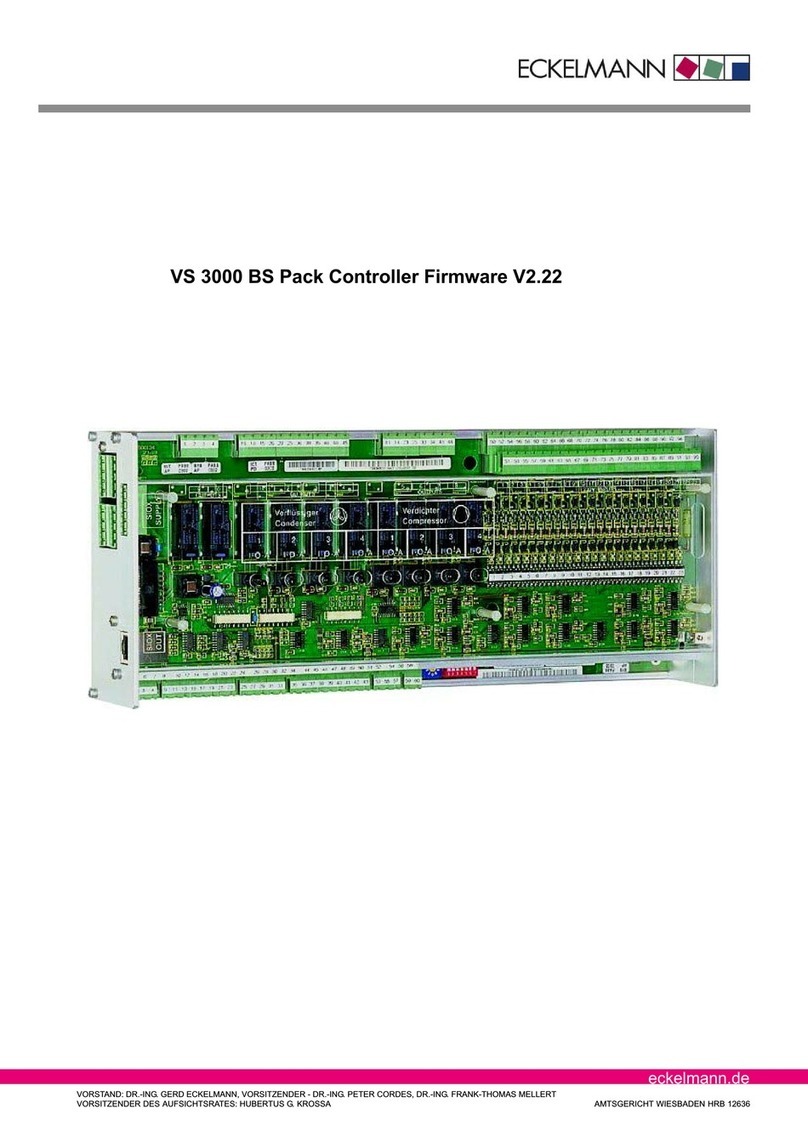
ECKELMANN
ECKELMANN VS 3000 BS User manual
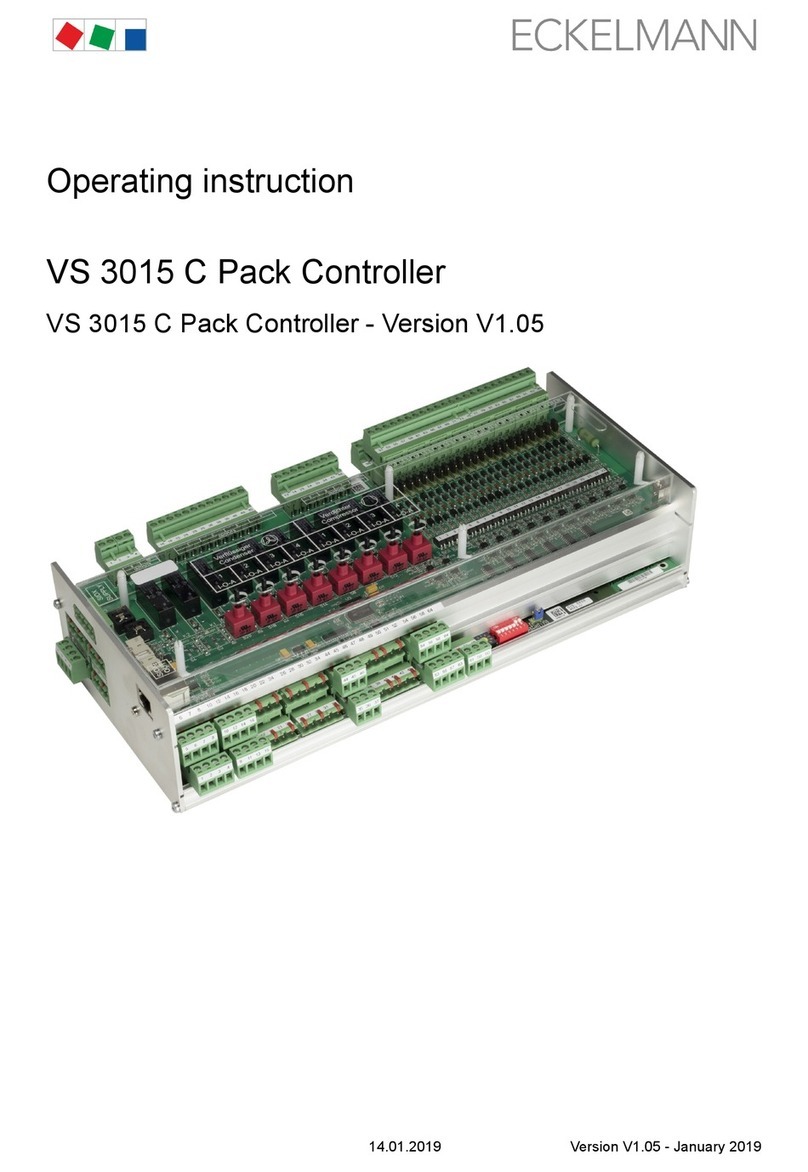
ECKELMANN
ECKELMANN VS 3015 C User manual
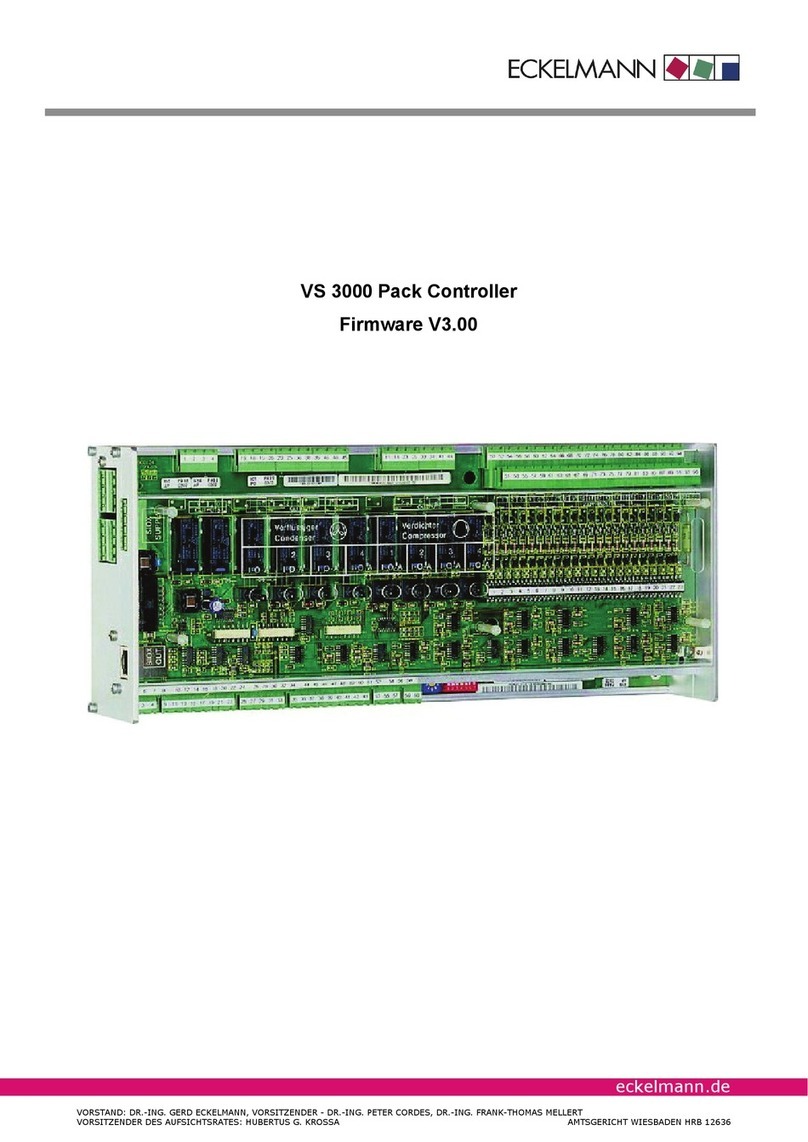
ECKELMANN
ECKELMANN VS 3000 User manual
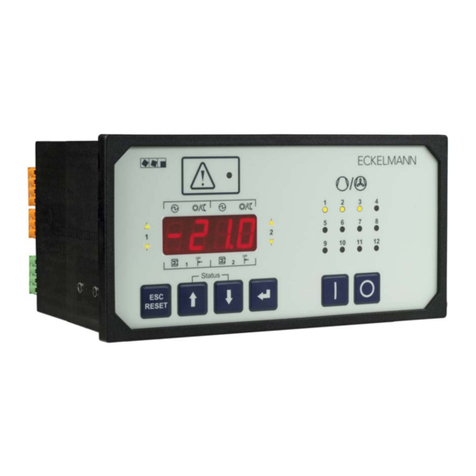
ECKELMANN
ECKELMANN VS 300 User manual
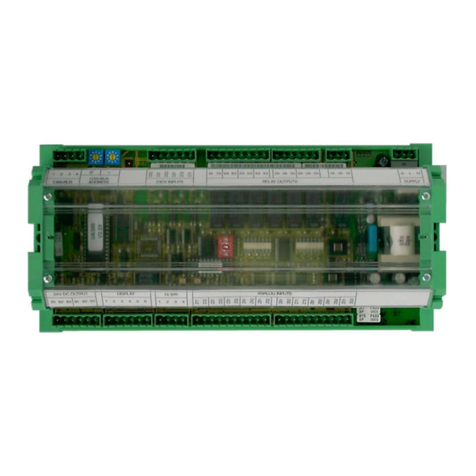
ECKELMANN
ECKELMANN UA 300 D User manual
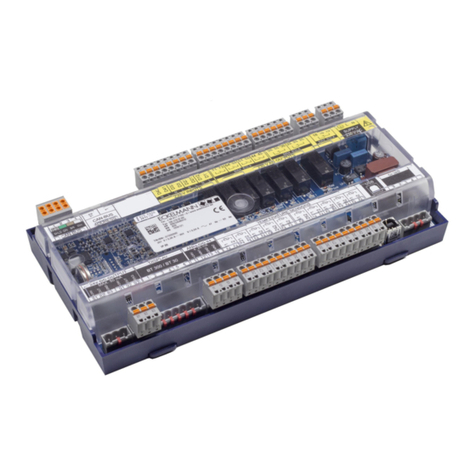
ECKELMANN
ECKELMANN UA 410 L User manual
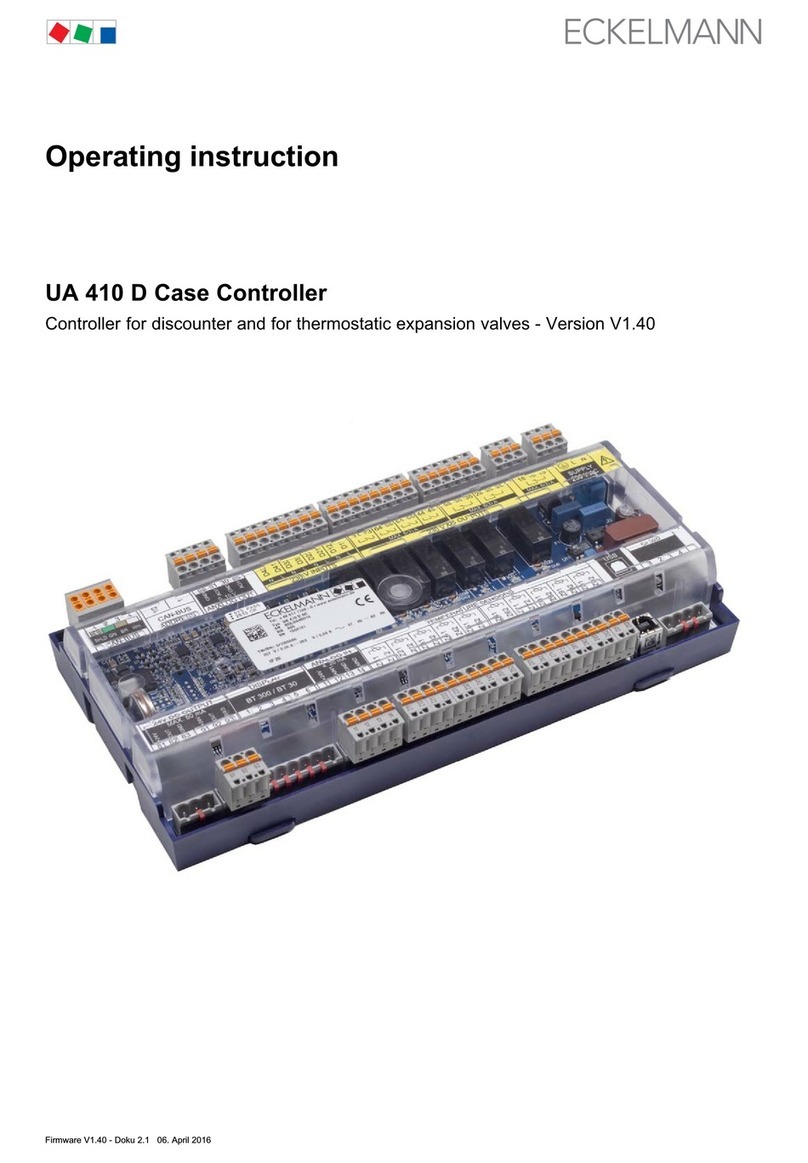
ECKELMANN
ECKELMANN UA 410 D User manual
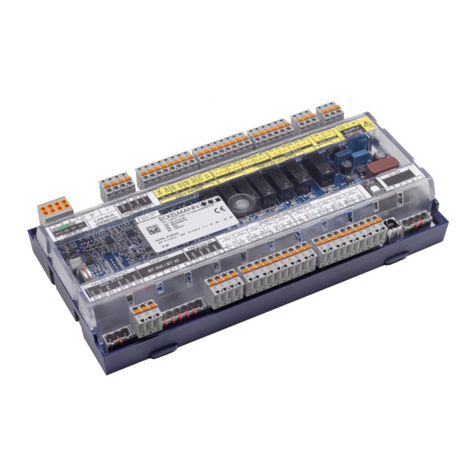
ECKELMANN
ECKELMANN UA 412 S User manual
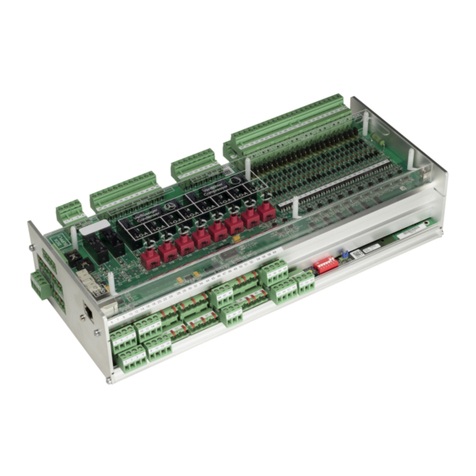
ECKELMANN
ECKELMANN VS 3010 BS User manual

ECKELMANN
ECKELMANN WRG 3010 E User manual
